Pack animal
A pack animal, also known as a sumpter animal or beast of burden, is an individual or type of working animal used by humans as means of transporting materials by attaching them so their weight bears on the animal's back, in contrast to draft animals which pull loads but do not carry them.
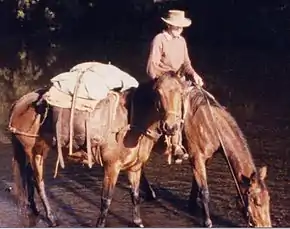
Traditional pack animals are diverse including camels, goats, yaks, reindeer, water buffaloes, and llamas as well as the more familiar pack animals like dogs, horses, donkeys, and mules.
Nomenclature
The term pack animal is traditionally used in contrast to draft animal, which is a working animal that typically pulls a load behind itself (such as a plow, a cart, a sled or a heavy log) rather than carrying cargo directly on its back.[1] For instance, sled dogs pull loads but do not normally carry them, while working elephants have been used for centuries to haul logs out of forests.[2]
The term pack animal can also refer to animals which naturally live and hunt in packs in the wild, such as wolves, hyenas, dogs etc.
Diversity
Traditional pack animals include ungulates such as camels,[3] the domestic yak, reindeer, goats,[4] water buffaloes and llama,[5] and domesticated members of the horse family including horses, donkeys, and mules.[6] Occasionally, dogs can be used to carry small loads.[7][8]
Pack animals by region
- Arctic - Reindeer and sled dogs
- Central Africa and Southern Africa - Oxen, mules, donkeys
- Eurasia - Donkeys, oxen, Horses, mules
- North America - Horses, mules, donkeys, goats
- North Africa and Middle East - Dromedaries, horses, donkeys, mules, oxen
- Oceania - Donkeys, horses, dromedaries, mules, oxen
- South America - Llamas, donkeys, mules
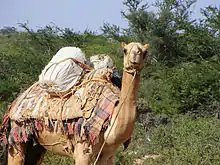
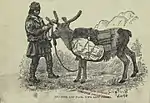 Pack reindeer with Sami driver from The land of the midnight sun, c. 1881
Pack reindeer with Sami driver from The land of the midnight sun, c. 1881
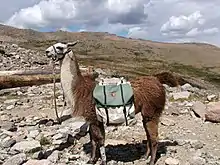 Pack llama, Rocky Mountain National Park, Colorado
Pack llama, Rocky Mountain National Park, Colorado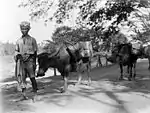 Pack water buffalo, Sumbawa, Indonesia, early 20th century
Pack water buffalo, Sumbawa, Indonesia, early 20th century Pack donkeys, Devon, England, c. 1906
Pack donkeys, Devon, England, c. 1906
Uses

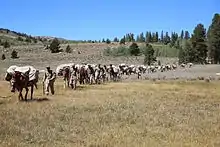
Hauling of goods in wagons with horses and oxen gradually displaced the use of packhorses, which had been important until the Middle Ages, by the sixteenth century.[9]
Pack animals may be fitted with pack saddles and may also carry saddlebags.[10]
While traditional usage of pack animals by nomadic tribespeople is declining, a new market is growing in the tourist expeditions industry in regions such as the High Atlas mountains of Morocco, allowing visitors the comfort of backpacking with animals.[6] The use of pack animals "is considered a valid means of viewing and experiencing" some National Parks in America, subject to guidelines and closed areas.[11]
In the 21st century, special forces have received guidance on the use of horses, mules, llamas, camels, dogs, and elephants as pack animals.[12]
Load carrying capacity
The maximum load for a camel is roughly 300 kg.[13]
Yaks are loaded differently according to region. In Sichuan, 165 pounds (75 kg) is carried for 30 km in 6 hours. In Qinghai, at 4100 m altitude, packs of up to 660 pounds (300 kg) are routinely carried, while up to 860 pounds (390 kg) is carried by the heaviest steers for short periods.[14]
Llamas can carry roughly a quarter of their body weight, so an adult male of 440 pounds (200 kg) can carry some 110 pounds (50 kg).[15]
Loads for equids are disputed. The US Army specifies a maximum of 20 percent of body weight for mules walking up to 20 miles a day in mountains, giving a load of up to about 200 pounds (91 kg). However an 1867 text mentioned a load of up to 800 pounds (360 kg). In India, the prevention of cruelty rules (1965) limit mules to 440 pounds (200 kg) and ponies to 154 pounds (70 kg).[16]
Reindeer can carry up to 40 kg for a prolonged period in mountains.[17]
See also
References
- "Our Right to be Outside: Three Mules". No Tech Magazine. 24 September 2013.
- "Elephants in Logging Operations in Sri Lanka". Food and Agriculture Organization. Retrieved 31 January 2016.
- "The Best Invention Since The Wheel". No Tech Magazine. 4 January 2012.
- "Pack Goats". No Tech Magazine. 13 December 2011.
- "Llamas as Pack Animals". Buckhorn Llama Co. 1997. Archived from the original on 18 August 2017. Retrieved 26 January 2016.
- "Pack-animal welfare checks introduced for the expeditions industry". The Donkey Sanctuary. 26 February 2015. Retrieved 26 January 2016.
- "Gear for Your Dog: Backpacks, Saddle Bags, Harnesses, and More". WebMD. Retrieved 31 January 2016.
- Barbara Fitzgerald. "The Modern Bark - Dog Training Tips: Find Your Ideal Dog Backpack - 5 Best Dog Backpacks Reviewed". Retrieved 31 January 2016.
- Aston, T. H. (2 November 2006). Landlords, Peasants and Politics in Medieval England. Cambridge University Press. pp. 54–55. ISBN 978-0-521-03127-1.
- "How Much Weight Can My Horse Carry?". Outfitters Supply. Retrieved 26 January 2016.
- "Horse & Pack Animal Use". National Park Service. Retrieved 26 January 2016.
- "FM 3-05.213 (FM 31-27) Special Forces Use of Pack Animals" (PDF). Headquarters, Department of the Army. June 2004. Retrieved 26 January 2016.
- CSIRO (2006). Model Code of Practice for the Welfare of Animals The Camel (Camelus dromedarius) (2nd ed.). CSIRO Publishing. p. 8.
- "Draught performance". Food and Agriculture Organization. Retrieved 31 January 2016.
- "Frequently Asked Questions about Llamas and Alpacas". Touch the Heart Ranch. Retrieved 31 January 2016.
- Bonner, Laurie. "How Much Weight Can Your Horse Safely Carry?". Equus Magazine. Retrieved 31 January 2016.
- Nickul, Karl (1997). The Lappish Nation. Psychology Press. p. 29. ISBN 978-0-7007-0922-9.
External links
| Wikimedia Commons has media related to Pack animals. |
- Llama Backpacking Documentary produced by Oregon Public Broadcasting
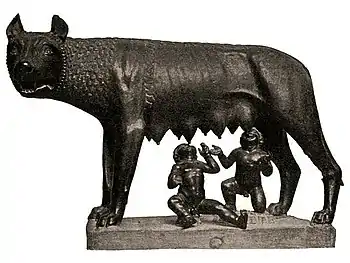
.jpg.webp)